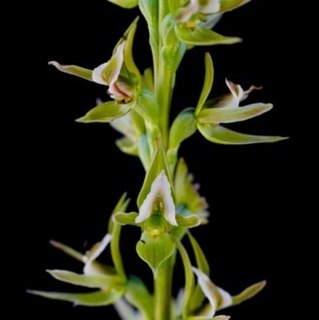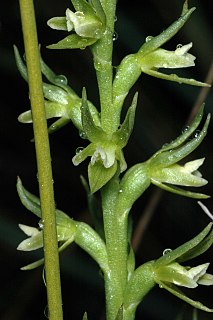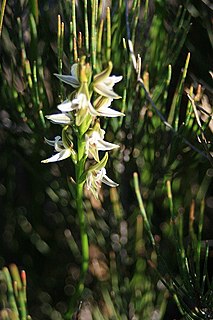Prasophyllum pyriforme, commonly known as the graceful leek orchid is a species of orchid species endemic to eastern Australia. It has a single tubular leaf and up to fifty greenish flowers with a pink or white labellum. As with others in the genus, the labellum is above the column rather than below it.
Prasophyllum australe, commonly known as the southern leek orchid or austral leek orchid, is a species of orchid and is endemic to south-eastern Australia. It has a single tubular, green leaf and up to fifty scented, greenish-brown flowers with red stripes.

Prasophyllum petilum, commonly known as the Tarengo leek orchid, is a species of orchid endemic to eastern Australia. It has a single tubular, green leaf and up to eighteen pinkish mauve to greenish flowers, well-spaced along a slender flowering stem. It is a small orchid, difficult to locate, generally growing in taller grasses.

Prasophyllum montanum, commonly known as the mountain leek orchid, is a species of orchid endemic to eastern Australia. It has a single tubular, green leaf and up to fifty scented, greenish to pinkish flowers. It grows in montane ecosystems at altitudes above 1,500 m (5,000 ft).
Prasophyllum campestre, commonly known as the sandplain leek orchid, or inland leek orchid, is a species of orchid endemic to eastern Australia. It has a single tubular, yellowish-green leaf and up to twenty greenish, strongly scented flowers with red, purplish, brown or white marks. It grows in the drier parts of Queensland, New South Wales and Victoria.

Prasophyllum lindleyanum, commonly known as the green leek orchid, is a species of orchid endemic to south-eastern Australia. It has a single smooth, tube-shaped leaf and up to twenty scented, greenish flowers with a greenish or white labellum with a pink tinge.

Prasophyllum canaliculatum, commonly known as the channelled leek orchid or summer leek orchid, is a species of orchid endemic to a small area of southern New South Wales. It has a single tubular, bright green leaf and up to twenty five scented, greenish-red or brownish flowers on a flowering stem. It grows in woodland at altitudes around 1,000 m (3,000 ft) where only about two hundred plants survive.

Prasophyllum caudiculum, commonly known as the Guyra leek orchid, is a species of orchid endemic to a small area of northern New South Wales. It has a single tubular, bright green leaf and up to thirty five greenish to reddish-brown flowers crowded along an erect flowering stem. It grows in grassy places near Guyra.
Prasophyllum goldsackii, commonly known as Goldsack's leek orchid, is a species of orchid endemic to South Australia. It has a single tubular green leaf and up to twelve green flowers with dark purple edges and tips. It is only known from two populations on each of the Yorke and Eyre Peninsulas.
Prasophyllum innubum, commonly known as the Brandy Mary's leek orchid, is a species of orchid endemic to a small region of New South Wales. It has a single tubular, bright green leaf and up to twenty brownish-green, white and purplish flowers. It is a very rare orchid with only about four hundred plants known.
Prasophyllum laxum, commonly known as the lax leek orchid, is a species of orchid endemic to a small region of South Australia. It has a single tubular leaf and up to twenty pale green, tan and lilac-coloured flowers. It was first collected in the 1960s in a location known as the Hundred of Koppio on the Eyre Peninsula but was not described until 2008 from a new collection in 2004.
Prasophyllum litorale, commonly known as the coastal leek orchid, is a species of orchid endemic to southern continental Australia. It has a single tubular leaf and up to forty flowers with red and green colouring and grows in sandhills near the sea.
Prasophyllum macrostachyum, commonly known as the laughing leek orchid, is a species of orchid endemic to the south-west of Western Australia. It has a single smooth, tube-shaped leaf and up to thirty yellowish-green and purple flowers. It is one of the few Western Australian leek orchids which is not stimulated by summer fires and also has an unusually long flowering period.
Prasophyllum milfordense is a species of orchid endemic to Tasmania. It has a single tubular, dark green leaf and up to thirty greenish-brown, white and purplish flowers. It is a very rare orchid, only found in a single location with a population of around 240 plants.
Prasophyllum morganii, commonly known as the Cobungra leek orchid, is a species of orchid endemic to a small area in Victoria. It has a single tubular leaf and up to eighty greenish flowers with purplish markings. It was known from a single population of fifteen plants but has not been seen since 1933 and is now presumed extinct.
Prasophyllum occultans, commonly known as the hidden leek orchid, is a species of orchid endemic to southern Australia. It has a single, smooth, tube-shaped leaf with a reddish-purple base and up to ten greenish flowers. It is a rare species found only in a few locations in South Australia and in far western Victoria.
Prasophyllum parviflorum, commonly known as the slender leek orchid, is a species of orchid endemic to eastern Victoria. It has a single tubular leaf and up to thirty greenish-brown to purplish flowers. Further studies of the species may indicate that some collections currently included may be of a different species.
Prasophyllum spicatum, commonly known as the dense leek orchid, is a species of orchid endemic to southern mainland Australia. It has a single tubular, green leaf and up to fifty brownish and white or greenish and white flowers crowded in a cylinder-shaped spike.

Prasophyllum striatum, commonly known as the streaked leek orchid or eastern hunchback orchid, is a species of orchid endemic to New South Wales. It has a single thin, tube-shaped leaf and up to ten greenish and whitish flowers with reddish or purplish stripes. It differs from other leek orchids in having a very thin leaf and prominently streaked flowers.
Prasophyllum truncatum, commonly known as the truncate leek orchid, is a species of orchid endemic to Tasmania. It has a single tubular, dark green leaf and up to twenty whitish flowers with purplish and greenish-brown markings. It is a late-flowering leek orchid and its flowering is stimulated by earlier fire.





